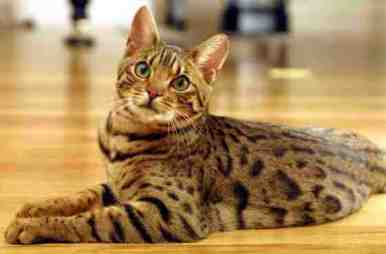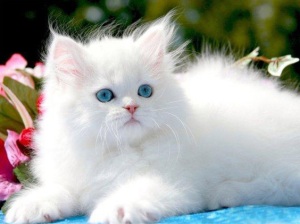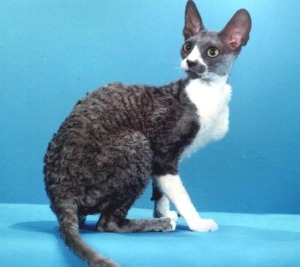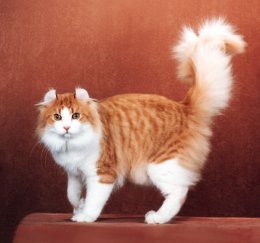Archive for category Cats
Ways to Keep a Tabby Cat Happy
Posted by gracelydia51 in Cats on August 28, 2012
 Tabby cats are not a breed. The coat of a tabby cat has a set of patterns, such as stripes, swirls, and a distinctive ‘M’ shaped mark on the forehead. The exact placement and shape of these patterns highly depends on the specific type of tabby. Like any other cat, tabby cats also need proper diet and stimulation to remain healthy, active, and happy.
Tabby cats are not a breed. The coat of a tabby cat has a set of patterns, such as stripes, swirls, and a distinctive ‘M’ shaped mark on the forehead. The exact placement and shape of these patterns highly depends on the specific type of tabby. Like any other cat, tabby cats also need proper diet and stimulation to remain healthy, active, and happy.
Cat Health:
You can keep your tabby cat happy by establishing its predictable feeding routine. For this, you need to feed your cat at the same time each day. It is better to use different types of foods and alternate both wet or dry food and ingredients for feedings.
If possible, provide your cat an access to running water. You can either provide running water from a tap at expected intervals or buy a cat fountain from a pet supply store.
Providing a small planter of cat grass, that is at least 2 inches tall, is also a good way to keep your cat happy. Place the planter away from the food and water dishes. Moreover, it is advisable to put any houseplants that are toxic to cats in a room where your cat is not allowed to go.
Place at least two litter boxes in two different rooms of the house, and do not change their place once they have been used. Clean them on daily basis or as required.
Cat Stimulation:
Keep your tabby cat happy by providing scratching posts or mats. It is preferable to place them near any object that the cat is presently scratching. You may need to scratch them yourself in order to teach the cat how to use them. Encourage your cat by feeding it after it begins using the post.
Get a cat-climbing tree from your local pet supply store and encourage the climbing behavior of your cat by placing a treat on higher platforms.
Cats love to watch outside world. Keeping window shades open will allow them a clear view of the outdoors. However, if your windows do have enough space to sit, you can provide a cat perch to sit and enjoy the outdoor scene.
Play with your tabby cat every day at the same time. You can also take it outside occasionally; however, you need to secure them with a leash to prevent them from running off and risking injury.
Interesting Facts about Bengal Cats
Posted by gracelydia51 in Cats on August 18, 2012
Bengal cats are among the most expensive cat breeds of the world. These cats have some unique genetic heritage and possess distinct personalities, unusual behavior patterns, and attractive visual appearance, which make them a popular cat breed among the cat owners.
Some of the most interesting facts about Bengal cats are as follows:
- Like other cat breeds, Bengal cats are intelligent, energetic, and interactive cats. They are a dynamic and active part of the family. However, they are not similar to the other cat breeds, and possess various characteristic that make them very special and different.
- Bengal cats are amazing athletes as they can rush around with great joy, climb doors and cupboards, and jump to huge heights.
- These cats often become total softies as they flop over and roll on their backs in joy, come up to you and snuggle your face, purring rowdily, then lastly curl up into happy little balls and fall fast asleep. In fact, Bengal cats crave love and affection of their owners.
- Bengal cats are fond of water, and can play happily, and even swim, in quite deep water. However, it is not necessary that all Bengal cats are swimmers.
- Bengal cats are not particularly noisy cats. Unlike some Siamese cats, they do not constantly commentate on their owners’ life; however, they do have a diverse range of candid calls, which they use when they feel the need.
- These cats love their food. The only problem is that they tend to climb inside the food bag before you can pour it out. Also, they not only carry off treats such as chicken pieces, but also guard them proudly with a low growl.
- Bengal cats are not fierce and wild animals. They are indeed domestic animals, however it is important to note that, being so active, these cats may totally inadvertently scratch people whilst galloping over them or jumping from them. Therefore, caution should be taken if you have small children in the family.
Facts about Maine Coon Cats
Posted by gracelydia51 in Cats on August 5, 2012
Maine Coon cats belong to a large cat breed that is the Native American long-haired cat breed. They are ideal for the harsh winters and varied seasons of the region. These cats are friendly and playful. They tend to be reserved with strangers; however, they are very adoring and understanding with their family. This makes them ideal for kids and dogs, and they have always been a popular and preferred companion.
Here are a few interesting facts about Maine Coon cats that will help you in understanding this large domesticated cat.
- There is a wide variety of Maine Coon cats with different colors and patterns. The most common are Tabbies and Tabby & Whites, whereas Maine Coons with solids and more exotic colors and patterns are quite rare.
- Although Maine Coon cats are known for their large size, however, because of their high vivacity and wisdom quotients, they are also labeled as “the Gentle Giants” in the feline world.
- Nine out of ten Maine Coon cats share one unique facet, i.e. their facial features have a clear M-shape on their brow. This feature can also present in Maine Coon mixes.
- The eye color of a Maine Coon cat can be a shade of gold, green, green-gold, or copper. White or bi-color patterned cats mostly have blue-eyes or odd-eyes.
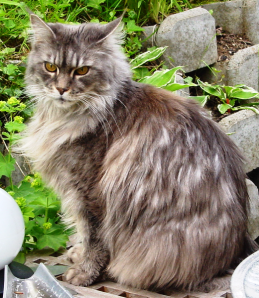
- Maine Coon cats can be polydactyl, which means that they can have six or more toes on their paws.
- Unlike Persian cats, which have long coat, these cats have middling thick fur with a ruff around their neck and chests, which look similar to a lion’s mane. Also, they have the longer hair around their legs.
- The fur of a Maine Coon has two layers, i.e. an undercoat and a supplementary tier of longer guard hair. This multi-layered coat gives this cat a noticeable look.
- Maine Coons are considered fully grown when they reach 4 to 5 years of age.
- The weight of a male Maine Coon cat is between 18 and 25 pounds, whereas females normally weigh between 7 and 11 pounds, reaching 16 pounds for a mature cat.
- Regardless of their large bodies, Maine Coon cats have tiny voices that squeak and chirp.
- Unlike other cats, Maine Coon cats love to play with water.
Facts about Russian Blue Cat
Posted by gracelydia51 in Cats on April 24, 2012
 The Russian Blue Cat (also known as Archangel Blue Cat) is believed to have originated from the port town of Arkhangelsk in Russia. In 1800s, it was brought to the UK and has been domestically bred since then.
The Russian Blue Cat (also known as Archangel Blue Cat) is believed to have originated from the port town of Arkhangelsk in Russia. In 1800s, it was brought to the UK and has been domestically bred since then.
The Russian Blue Cat is famous for its silver-blue coat that shows off its wiry frame and complements its vibrant, dark green eyes. It has a long, slim body with short fur, and its coat is known as “double coat” as it has a soft, velvety undercoat that helps in providing the cat with an additional insulation in the extreme northern winters. The topcoat fur (even if sometimes a soft black in color) can be a real shade of blue with silver tips, giving the cat an iridescent look.
These cats are recognized as highly intelligent and playful; however, they are really shy around strangers. Moreover, they are quite easy to train and are well known for developing close bonds with their owners.
Since the saliva and sebum of Russian Blue Cats contain less of a certain protein than many other cats, they are among the hypoallergenic breeds of cats.
The purebred Russian Blue Cat does not have any white markings on its body, however in rare cases, a ‘locket’ of white fur can be found on its throat, which is considered as an extremely negative feature in cat shows. Another prominent feature of a purebred Russian Blue Cat is the positioning of its ears on its head, which are usually attached to the head at a rakish angle.
Russian Blue Cats are popular due to their calm and loving nature. In addition, they are one of the few domestic breeds that are not prone to illness or carry genetic defaults.
Persian Cat Care – Grooming
Posted by gracelydia51 in Cats on April 10, 2012
Persian cats are longhaired cat breeds and require regular grooming, particularly if your pet cat is allowed free-wander. Unlike shorter hair cats, its grooming can be difficult. This is because these cats have thick coat along with an undercoat, which feels like there are two coats instead of one. Therefore, these cats need regular grooming in order to stay clean, healthy and happy. Moreover, grooming is an ideal time to shower your pet cat with love and affection.
The grooming is of great importance to keep your Persian cat clean, happy, healthy, and comfortable. Some of the major advantages of grooming are as follows:
 Brushing and bathing removes unwanted dust, grit, dirt and loose hair as well as lifts dead skin cell flakes.
Brushing and bathing removes unwanted dust, grit, dirt and loose hair as well as lifts dead skin cell flakes.- Daily brushing increases blood circulation, hence improving muscle tone and invigorating healthy new hair growth.
- Brushing separates each hair, making your cat’s wonderful coat even fuller and fluffier.
- Brushing removes excess hair, reducing the ingestion of hair during self-grooming. This will reduce cat fur balls.
- Regular grooming reduces shedding, which means less cat fur around the house, making it easier for those humans who are vulnerable to allergies to cope.
- A neglected coat can be easily tangled, matted, and knotted, making it a perfect breeding spot for parasites.
- Grooming is a perfect time to examine your Persian for possible ticks, lice, mites, or symptoms of any other minor skin, eyes, ears and mouth diseases.
Brushing with a fine wire brush on a daily basis is suggested in order to prevent matting of the fur, forming of knots, and shedding of hair. Claw trimming is also an important part of cat grooming, and should not be neglected.
Although, it highly depends on the nature of your Persian cat, however, a large number of cats enjoy getting brushed and groomed. It is better to start grooming routine as kitten so that it can get used to it.
Remember that you should never wake your cat from sleep or try to groom it when it is asleep. Moreover, postpone the grooming session until later if your cat become stressed and irritated during the session.
Types of Cats
Posted by gracelydia51 in Cats, Small Mammals on January 26, 2012
There are a large number of different types of cats, which makes it difficult to categorize them. However, we can categorize domesticated cats on the basis of their length and types of their coat. Other popular categories that are used include classification based on their physical features and size.
Here are some of the most popular cat types.
Long-haired Cats:
Long-haired cats usually belong to the areas with cold climates. Their long hair keeps them warm in extreme low temperatures of their surroundings. Popular examples include Persian cats, Birman cats, and Siberian cats.
Hairless Cats:
As the name shows, hairless cats do not have hair on their body. They look bald, which is thought to be caused by natural mutation of their species. Popular hairless cats include Sphynx, the Dwelf, Bambino, and the Minskin.
Rexed Cats:
Rexed cats have curly hair, and this feature can be passed on from one offspring to another. However, the visibility of this characteristic is held by either dominant or recessive genes. Popular examples of these cats include Devon rex cat, Cornish rex cat, and the Skookum cat.
Short-legged Cats:
Cats that are categorized according to their physical features include short-legged cats. The most popular short-legged cats include Munchkin cat, Bambino, Lambkin, and Genetta. Since the cats of this group have short legs, therefore they are often called “dwarf cats”.
Short-tailed Cats:
These cats extremely short tails, which look similar to lumps. The most popular cats that have short tail include the Cymric, the American Bobtail, and the Manx.
Atypical-eared Cats:
These types of cats have either curled or folded ears. Sometimes, their ears look asymmetrical. The most popular examples of such cats include American Curl and the Scottish Ford.
Ragdoll Cat Psychology Facts
Posted by gracelydia51 in Cats on November 28, 2011
Ragdoll cats make great pets as they are ideal indoor cats. Unlike regular cats, these cats do not chase mice or other things. However, they do need fresh air occasionally. It is important not to leave your pet Ragdoll unsupervised because they can easily get lost, can be stolen, get hit by a car, or scared by a dog. Also, these cats really love strangers, particularly the smelly ones. Therefore, keep an eye on them when taking them out.
Ragdolls have the ability to learn the things fast that they should and shouldn’t do. However, knowing that the particular thing they are doing is wrong, they still keep on doing it. These cats can easily be familiar with travel or wear a collar, particularly if they are trained for this at a young age.
Ragdoll cats are thought to be the most sociable cats. They are very fond of their owner and people on the whole and mostly enjoy being with other cats.
Certainly, there are exceptions as some Ragdolls do not like any other species except humans. These cats really enjoy the company of children who treat these cats with affection and love.
Although Ragdoll kittens are generally quite active however as they grow older, they tend to be well-tempered and calm creatures. These cats enjoy fetching tossed toys, while others like a combination of a game of hide and seek and tag with their owner. They always enjoy your company when you spend some time playing with them.
When called, Ragdoll cats often answer in their soft low voice. Their sounds are so expressive that sometimes it seems that they answer you back. In short, Ragdoll cat is a perfect choice if you wish to have a lovable and trustworthy pet.
Information about Abyssinian Cat
Posted by gracelydia51 in Cats on October 17, 2011
The Abyssinian, often called the “Aby”, is active, curious and highly-spirited cat. It is a popular breed of domesticated shorthair cat with a unique ticked coat. Although there are a number of stories about its origin, however the actual origin is unknown.
The Abyssinian cat has a graceful, medium-sized, brawny but slim body. Its short, silky and close lying coat with ticked coloration makes it a distinctive cat. Its head is broad and rather wedge-shaped with almond-shaped eyes. Its eye colors can be gold, hazel, green or copper. The ears of Aby are somewhat pointed, relatively large, and very alert. Its legs are slender, with a fine bone structure. Its paws are small and oval in shape. The tail of Abyssinian is long and fairly tapering at the end.
Apart from ruddy, sorrel and blue colors, Abyssinian cats are also available in rare coat colors, such as Red, Tortoiseshell, Lilac, Chocolate, and Cream.
When Abyssinian cat is viewed in profile, its nose and chin mostly form a straight vertical line. An m-shaped marking, also known as “frown lines”, can be seen in the fur on its forehead (above its eyes). These frown lines can be tinted tawny, sorrel (red, silver cinnamon), blue fawn or red.
Abyssinian cats are extremely intelligent, playful and inquisitive cats. They enjoy their human companions, and like to be involved in everyday family life. However, they are generally not ‘lap cats’. These cats also love to play a game of fetch with their owners. They do not talk much and have a quiet, appealing voice.
Although Abyssinians are active and lively cats, however they have a few genetic defects. They are susceptible to Gingivitis and tooth decay. This problem can be minimized by training the cat to regular tooth brushing, applications of fluoride, and periodic professional teeth checkups. These cats are also prone to Amyloidosis, which is a renal disease considered to be hereditary.
